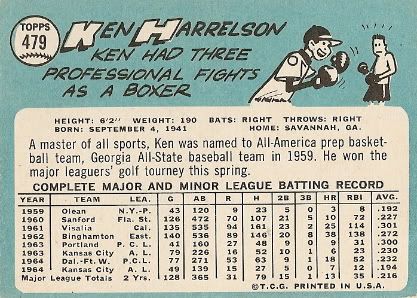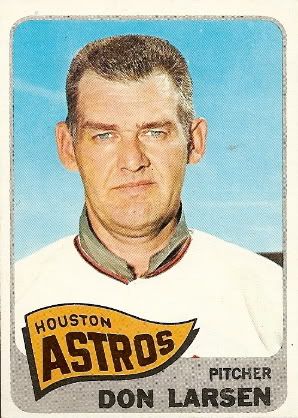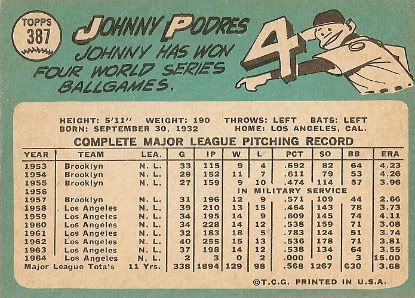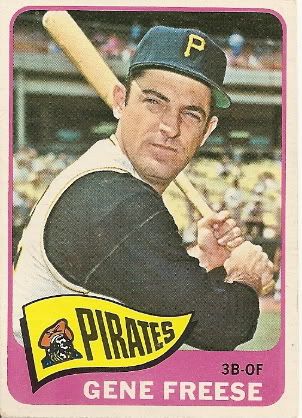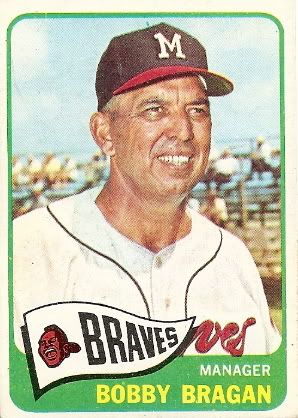
Wow. I'm sure I've talked about how hit-or-miss these multi-rookie cards are, but this is almost certainly the best of the bunch. The Braves Rookie Stars card with
Clay Carroll and
Phil Niekro is the only challenger, I'd say. It's hard to beat six combined All-Star appearances and 11 Gold Gloves, though!
-A native of Cushing, OK, Paul attended high school in Los Angeles before signing with the Mets in 1962.
-The Orioles snatched him up via the (now defunct) first-year minor league draft, and he made his major league debut late in 1964 at age 20.
-Earned the O's starting center field job the following year, but really came on in 1966. That year he hit .277 in the regular season and his solo home run off of
Claude Osteen delivered a 1-0 win for the Birds in the
third game of the World Series. In the next game, he caught the final out to clinch Baltimore's first championship.
-Won the first of his eight Gold Gloves in 1967 and batted a career-high .293 and led the American League with 12 triples. He was a speedy and dazzling defender in center field who played especially shallow, often racing back to the wall to rob opposing hitters.
-Was an All-Star for the first time in 1969 (he would return to the Midsummer Classic in 1973), when he hit .285 and established personal bests in runs (102), doubles (32), home runs (26), and RBI (76), and stole 20 bases for the first time. He batted .400 and drove in six runs in the Orioles' three-game ALCS sweep of the Twins, but (like many of his teammates) his bat fell cold in the shocking five-game World Series loss to the Mets.
-Had a memorable hot streak in the 1970 World Series win over the Reds, batting .474 (9-for-19) in five games. For his career, he was a .288 hitter with the O's and Yankees in six Fall Classics (his teams won four and lost two).
-After his average dipped to .197 in 1976, Baltimore traded Paul to the Yankees. He pulled reserve duty in the Bronx for two years, memorably replacing
Reggie Jackson in right field in mid-inning on
June 18, 1977 when Jackson enraged manager
Billy Martin with a supposed lack of effort on a
Jim Rice double. Martin and Jackson came to blows in the dugout in a nationally televised game.
-After a poor season with the Reds in 1979, Blair retired and took a job with the Yankees as a minor league instructor, but returned to active duty in June for a dozen games, mostly as a defensive replacement. He finished his career with a .250 average in parts of 17 seasons, to go with 134 home runs, 620 RBI, and 171 steals.
-Paul kept busy after his playing days, serving as head coach at Fordham University (1983) and Coppin State (1998-2002) and coaching in the Astros organization. He also briefly played for the Gold Coast Suns of the Senior Professional Baseball Association in 1989.
-Blair currently lives in Owings Mills, MD and still makes appearances at Orioles events. Though he suffered a heart attack last December, he recovered quickly and took part in a reunion of members of the 1970 World Champs at last month's Orioles FanFest.
Fun facts about Dave(y) Johnson:-Davey was born in Orlando, FL, and briefly attended Texas A & M University before signing with the Orioles in 1962.
-He debuted with the O's in the 1965 season at age 22. Early the following season, they traded starting second baseman
Jerry Adair to clear the way for Johnson.
-Was an All-Star for the first of four seasons in 1968, and won the first of three straight Gold Gloves the following year.
-Starred in the 1970 postseason, batting .364 with two homers in a three-game ALCS sweep of the Twins and adding a .313 mark with a .476 on-base percentage in the World Series victory over the Reds.
-His finest season in Baltimore came in 1971, when he hit .282 with 18 home runs and 72 RBI.
-After slumping badly in 1972, he was traded to the Braves to make way for the younger
Bobby Grich. Davey's first season in Atlanta was remarkable, as he broke
Rogers Hornsby's 50-year-old record for home runs by a second baseman, walloping 43 and joining
Hank Aaron and
Darrell Evans as the first trio of teammates to top 40 homers in a season. He was named Comeback Player of the Year in the N. L.
-Spent 1975 and 1976 in Japan with the Yomiuri Giants, where he was chosen by revered manager Shigeo Nagashima as the first foreign player on the team in nearly a decade. For much of his time with the Giants, he battled injuries as well as his manager and teammates. Despite hitting 26 homers in 1976, winning a Gold Glove, and spurring a worst-to-first season for his club, he was essentially blackballed from the league after feuding with Nagashima and refusing a pay cut.
-Returned to the U.S. and played well in 1977 and 1978 in reserve duty for the Phillies and Cubs. Finished his playing career with a .261 average, 136 home runs, and 609 in parts of 13 seasons.
-Was a successful manager for the Mets (1984-1990), Reds (1993-1995), Orioles (1996-1997), and Dodgers (1999-2000), finishing first or second in 11 of his 12 full seasons. His greatest triumph came in 1986, as he led the Mets to a 108-54 record and a thrilling World Series win over the Red Sox. He often clashed with ownership, leading to his frequent departures from clubs.
-Since his major league managerial career ended, Davey has been active with USA Baseball, managing America's teams in the 2005 and 2007 Baseball World Cups (winning the crown in the latter by toppling Cuba), the 2008 Summer Olympics (bronze medal), and 2009 World Baseball Classic. He is currently a senior advisor for the Washington Nationals.









